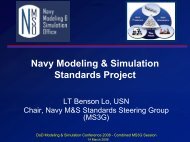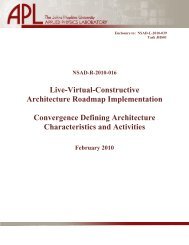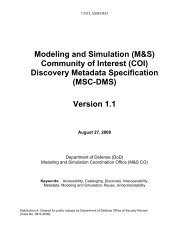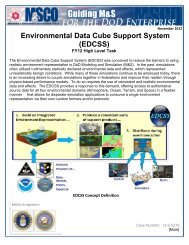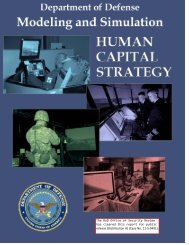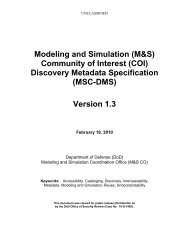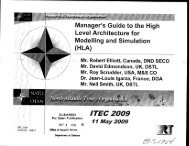LVCAR-I Convergence Final Report - Modeling & Simulation ...
LVCAR-I Convergence Final Report - Modeling & Simulation ...
LVCAR-I Convergence Final Report - Modeling & Simulation ...
You also want an ePaper? Increase the reach of your titles
YUMPU automatically turns print PDFs into web optimized ePapers that Google loves.
Live-Virtual-Constructive Architecture Roadmap Implementation,<br />
<strong>Convergence</strong> <strong>Final</strong> <strong>Report</strong><br />
3. CONVERGENCE ACTIVITIES<br />
This section describes the activities necessary to get from the current architecture<br />
implementations to the recommended converged approach.<br />
3.1 CONVERGENCE SYSTEMS ENGINEERING (CSE)<br />
The convergence approach shown in Figure 4 depends on a systems engineering process<br />
that displaces functionality from the legacy architecture infrastructures into the CSI. Pursuing a<br />
spiral development approach to this displacement minimizes the risk exposure while providing<br />
incremental deliverables. These systems engineering activities will involve reusable software<br />
engineering expertise and detailed technical knowledge of the legacy architecture<br />
implementations.<br />
3.1.1 CSE Requirements and Risk Analysis<br />
The state and sequence diagrams from Section 2 will be completed during the <strong>LVCAR</strong>-<br />
CT effort for all the use cases developed by the <strong>LVCAR</strong>-CT. This baseline technical approach<br />
will provide a reference for spiral development of a requirements specification for the converged<br />
approach. The requirements will be mapped to the available reusable software with unrestricted<br />
rights and the resulting designs evaluated for technical risk. CSI implementation priorities will be<br />
set to retire the risks as quickly as possible.<br />
3.1.2 CSE Enterprise Metadata Communication<br />
The internal enterprise metadata shown in Figure 2 must be communicated through the<br />
CSI before simulation data paths can be established. Initial integration and checkout of the CSI<br />
implementation and coupler prototypes can be conducted using this information.<br />
3.1.3 CSE Prototype Evaluation<br />
Evaluation criteria must be set as the CSI implementation proceeds and test results from<br />
coupler prototypes are available. The assessment of this software demonstrates that the<br />
implementation risks have been addressed and may indicate new areas for implementation.<br />
3.2 COMMON TRAINING INSTRUMENTATION ARCHITECTURE (CTIA)<br />
CTIA is based on a Service-Oriented Architecture (SOA). Live Training Transformation<br />
(LT2) components within the CTIA framework interact with services via defined Interfaces<br />
(defined using the Common Object Request Broker Architecture [CORBA] Interface Definition<br />
Language [IDL]). The components use these CTIA services to mediate their interaction with one<br />
another through the CTIA framework. As shown in Figure 11, the integration approach for<br />
converging CTIA is centralized at the Range Operations Center. Responsibility for these<br />
activities should be with the CTIA architects in order to maintain close integration with the rest<br />
of the CTIA solution.<br />
Page 13



